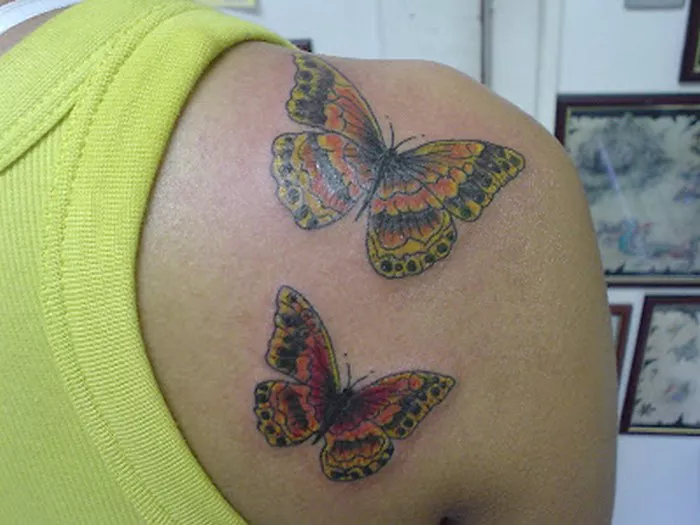Butterfly tattoos have surged in popularity, adorning the bodies of countless individuals worldwide, with a notable prevalence among women. This phenomenon begs the question: why do so many girls have butterfly tattoos? Delving into the intricate layers of cultural significance, trend analysis, personal stories, design variations, placement, and aftercare considerations, we embark on a journey to unravel the allure behind these captivating symbols.
Cultural Significance
Butterflies hold profound symbolism across various cultures, often representing themes of transformation, freedom, and beauty. In many ancient civilizations, butterflies were revered as symbols of rebirth and metamorphosis due to their remarkable life cycle, transitioning from a humble caterpillar to a breathtaking winged creature.
In Japanese culture, butterflies symbolize the transient nature of life and are associated with the concept of mono no aware, which emphasizes the beauty of impermanence. Similarly, in Chinese culture, butterflies are revered as symbols of love and joy.
In Native American folklore, butterflies are viewed as messengers of the spirit world, carrying messages from the divine realm. Among indigenous tribes, butterfly imagery is often incorporated into rituals and ceremonies, signifying spiritual transformation and guidance.
Trend Analysis
The surge in popularity of butterfly tattoos can be attributed to several factors. Firstly, the increasing acceptance of tattoos in mainstream society has led to a proliferation of tattoo culture, with more individuals embracing body art as a form of self-expression. Additionally, the rise of social media platforms has facilitated the sharing of tattoo designs and inspirations, fueling trends and influencing personal choices.
Furthermore, the versatility of butterfly tattoos appeals to a wide demographic, transcending age, gender, and cultural boundaries. Whether rendered in vibrant colors or intricate black ink, butterfly designs offer endless possibilities for customization, allowing individuals to imbue them with personal meaning and symbolism.
Personal Stories
Behind every butterfly tattoo lies a unique narrative, reflecting the individual’s journey, aspirations, and identity. Through anecdotes and interviews with tattoo enthusiasts, we gain insight into the deeply personal significance of these designs.
For some, a butterfly tattoo may serve as a symbol of resilience and transformation, commemorating overcoming adversity and emerging stronger than before. For others, it may represent a connection to nature and the beauty of the natural world, serving as a reminder to embrace life’s fleeting moments.
Design Variations
Butterfly tattoos come in a myriad of styles and interpretations, ranging from minimalist silhouettes to elaborate, hyper-realistic depictions. Traditional designs draw inspiration from classic tattoo motifs, featuring bold lines and vibrant colors, while contemporary interpretations may incorporate elements of surrealism or abstract art.
From delicate watercolor renderings to bold geometric patterns, the diversity of butterfly tattoo designs reflects the individuality of the wearer, allowing them to express their unique aesthetic preferences and personality traits.
Placement and Meaning
The placement of a butterfly tattoo can also carry symbolic significance. While some opt for prominent placements such as the forearm or upper back to showcase their design, others may choose more discreet locations such as the ankle or wrist for a subtle yet meaningful adornment.
In terms of symbolism, the location of a butterfly tattoo can vary depending on cultural beliefs and personal interpretation. For instance, a butterfly tattoo placed near the heart may symbolize love and affection, while one adorning the lower back may evoke notions of sensuality and allure.
Aftercare and Considerations
Before embarking on the journey of getting a butterfly tattoo, it is essential to consider various factors, including aftercare and maintenance. Proper tattoo aftercare is crucial for ensuring optimal healing and longevity of the tattoo. This includes keeping the tattoo clean and moisturized, avoiding exposure to sunlight, and following the artist’s instructions for care.
Additionally, individuals should carefully consider the design, placement, and size of their butterfly tattoo to ensure it aligns with their personal preferences and lifestyle. Consulting with a reputable tattoo artist and conducting thorough research beforehand can help mitigate any potential regrets or complications down the line.
In conclusion, the widespread popularity of butterfly tattoos among girls and women can be attributed to a combination of cultural significance, trend dynamics, personal narratives, design versatility, and symbolic meanings. Whether as a symbol of transformation, a nod to cultural heritage, or simply a beautiful form of self-expression, butterfly tattoos continue to captivate and inspire individuals worldwide, leaving an indelible mark on both body and soul.

